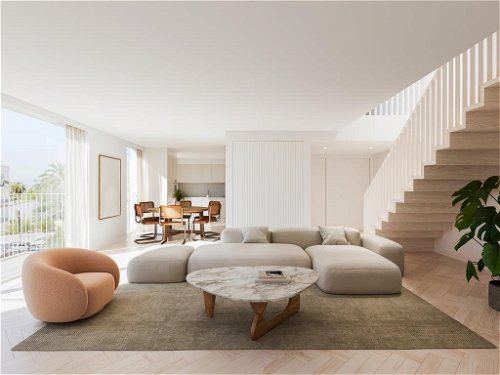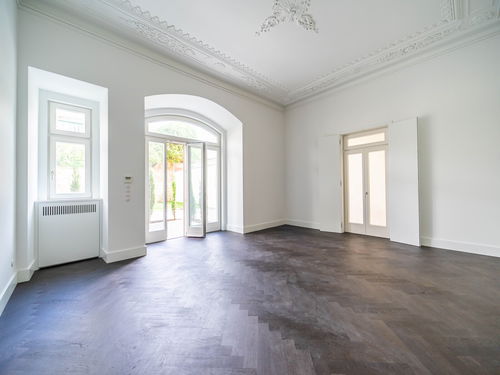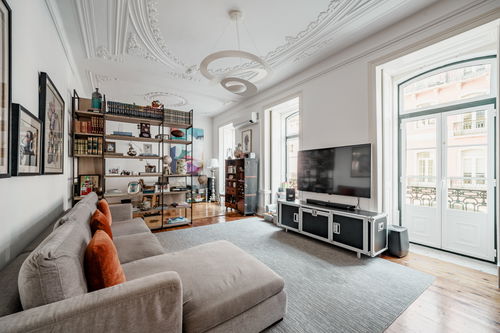Four-bedroom house in need of renovation in Alto de Santo Amaro, Alcântara, Lisbon House with planning permission for a four-bedroom loft in Alto de Santo Amaro, Alcântara, Lisbon. This 160 sq m property has planning permission for a four-bedroom loft with a gross private area of 242 sq m and 30 sq m of outdoor space. It will have the following layout: On the ground floor there will be a garage with access to the inside of the property, a guest bathroom, a kitchen with access to the dining room (24 sq m) and an outdoor dining area (15 sq m), a lounge (18 sq m) with access to a terrace with a hot tub (15 sq m). The first floor will have two suites, one 16 sq m with am 8 sq m walk-in wardrobe and the other 20 sq m. The second and final floor will have two bedrooms (each 12 sq m) sharing a bathroom (7 sq m) and a hallway area that can be converted into a study (10 sq m). Features: – Property with planning permission – Outdoor space – Garage – Air conditioning – Lounge fireplace with heat exchanger
: Sitting on the edge of the Tagus, Alcântara covers an area of 4.39 km2 and has a population of 13,911. The parish was created on 8 April 1770, when it was called São Pedro in Alcântara due to the transfer to this area what was until then the parish of São Pedro in Alfama. It is often associated with the Arabic word ‘Al-quantãrã’, ‘the bridge’, referring to the existence of a bridge over the river Alcântara, which has now disappeared. Alcântara has hills and valleys, along with natural resources on the banks of the river and fertile land that allowed a rich and varied agriculture, with many vegetable gardens in the alluvial valleys, vineyards and cereals, and limestone quarries with lime kilns. It was these conditions that attracted people to settle here during the Muslim occupation, albeit spread apart. It was in the 18th century that Alcântara began to urbanise, coinciding with the creation of the parish. The factory buildings from the late 19th century, which so marked the neighbourhood in the first decades of the 20th century, have since been abandoned. The industrialisation of Alcântara in the 2nd half of the 19th century gave way, a hundred years later, to the inverse process and a profound social transformation, and most of the properties today are residential and commercial buildings.
The information provided on this webpage has been obtained from sources believed reliable, this may be subject to errors, change of price, prior sale, or withdrawal without notice. Fine Luxury Property Ltd®, it’s partners and collaborators do not guarantee the accuracy of any information contained on our websites.
- Property for sale America
- Property for sale Arizona
- Property for sale Boston
- Property for sale New York
- Property For Sale California
- Property for sale Philadelphia
- Property For Sale Colorado Springs
- Property for sale Chicago
- Property for sale Florida
- Property For Sale Las Vegas
- Property for sale Texas
- Property for sale Washington
- Property For Sale Argentina
- Property For Sale Austria
- Property for sale Azerbaijan
- Property For Sale Bahamas
- Property For Sale Barbados
- Property For Sale Belgium
- Property For Sale Belize
- Property For Sale Bermuda
- Property for sale Brazil
- Property for sale British Virgin Islands
- Property for sale Bulgaria
- Property For Sale Canada
- Property for sale Canary Islands
- Property for sale China
- Property For Sale Costa Rica
- Property For Sale Czech Republic
- Property for sale Finland
- Property for sale Georgia
- Property For Sale Germany
- Property for sale Henderson Island
- Property for sale Hungary
- Property For Sale India
- Property for sale Indonesia
- Property For Sale Tel Aviv
- Property For Sale Jerusalem
- Property For Sale Italy
- Property For Sale Lebanon
- Property For Sale Luxembourg
- Property for sale Malaysia
- Property For Sale Melbourne
- Property For Sale Monaco
- Property For Sale Morocco
- Property For Sale Netherlands
- Property for sale Norway
- Property For Sale Pakistan
- Property For Sale Panama
- Property For Sale Philippines
- Property For sale Qatar
- Property for sale Romania
- Property for sale Russia
- Property for sale Saudi Arabia
- Property for sale Singapore
- Property for sale Slovenia
- Property for sale South Africa
- Property for sale Spain
- Property For Sale Sri Lanka
- Property For Sale Sweden
- Property for sale Switzerland
- Property For Sale Turkey
- Property For sale Turks and Caicos Islands
- Property For Sale Rotterdam
- Property for sale United Kingdom
- Property for sale England
- Property For Sale Ireland
- Property For Sale Gibraltar
- Property For Sale Jersey
- Property For Sale Guernsey
- Property For Sale Scotland
- Property For Sale Wales
- Property for sale Uruguay
- Property for sale Vietnam

FLP
- Property for sale America
- Property for sale Arizona
- Property for sale Boston
- Property for sale New York
- Property For Sale California
- Property for sale Philadelphia
- Property For Sale Colorado Springs
- Property for sale Chicago
- Property for sale Florida
- Property For Sale Las Vegas
- Property for sale Texas
- Property for sale Washington
- Property For Sale Argentina
- Property For Sale Austria
- Property for sale Azerbaijan
- Property For Sale Bahamas
- Property For Sale Barbados
- Property For Sale Belgium
- Property For Sale Belize
- Property For Sale Bermuda
- Property for sale Brazil
- Property for sale British Virgin Islands
- Property for sale Bulgaria
- Property For Sale Canada
- Property for sale Canary Islands
- Property for sale China
- Property For Sale Costa Rica
- Property For Sale Czech Republic
- Property for sale Finland
- Property for sale Georgia
- Property For Sale Germany
- Property for sale Henderson Island
- Property for sale Hungary
- Property For Sale India
- Property for sale Indonesia
- Property For Sale Tel Aviv
- Property For Sale Jerusalem
- Property For Sale Italy
- Property For Sale Lebanon
- Property For Sale Luxembourg
- Property for sale Malaysia
- Property For Sale Melbourne
- Property For Sale Monaco
- Property For Sale Morocco
- Property For Sale Netherlands
- Property for sale Norway
- Property For Sale Pakistan
- Property For Sale Panama
- Property For Sale Philippines
- Property For sale Qatar
- Property for sale Romania
- Property for sale Russia
- Property for sale Saudi Arabia
- Property for sale Singapore
- Property for sale Slovenia
- Property for sale South Africa
- Property for sale Spain
- Property For Sale Sri Lanka
- Property For Sale Sweden
- Property for sale Switzerland
- Property For Sale Turkey
- Property For sale Turks and Caicos Islands
- Property For Sale Rotterdam
- Property for sale United Kingdom
- Property for sale England
- Property For Sale Ireland
- Property For Sale Gibraltar
- Property For Sale Jersey
- Property For Sale Guernsey
- Property For Sale Scotland
- Property For Sale Wales
- Property for sale Uruguay
- Property for sale Vietnam













